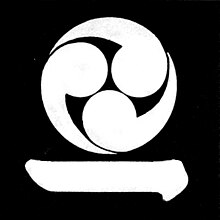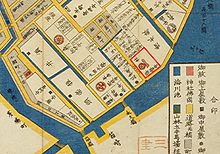Hayashi (clan, Jōzai)

The Hayashi ( Japanese 林氏 , Hayashi-shi ) only rose to daimyo in the 19th century. With an income of 10,000 Koku , the Hayashi who last resided in Jōzai belonged to the small Fudai daimyō of the Edo period .
history
In 1825, Hayashi Tadafusa (忠 英) rose from the Hatamoto status in the Shogunate to become Wakatoshiyori. This increased his income by 7,000 koku to 10,000, and he became a daimyo. Tadafusa received a small fiefdom in Kaibuchi (海 淵) in the province of Kazusa, built himself a permanent house ( jinya ) there and called his fiefdom Kaibuchi-han. His second son Tadaakira (忠 旭) took over the fiefdom in 1841, moved his seat to Jōzai (請 西) in 1850 and changed the name of the fief to Jōzai-han. In 1856 Tadaakira was followed by his younger brother Tadayohi.
- Tadataka (忠 崇; 1848–1941), sixth son of Tadayoshis, was successor and last daimyo in 1867. Tadataka fought on the Tokugawa side in the Boshin War , joined Enomoto Takeaki , and finally surrendered in Sendai. In 1872 he was released after internment and then held the title Vice Count. When Asano Nagakoto, formerly the daimyo of Hiroshima, died in 1937, Tadataka was the last surviving daimyo of the Edo period.
Remarks
Individual evidence
literature
- Miyaji, Saichiro (Ed.): Bakumatsu shoshu saigo-no hanshu-tachi. Higashinihon-hen. Jinbunsha, 1997. ISBN 978-4-7959-1905-1 .
